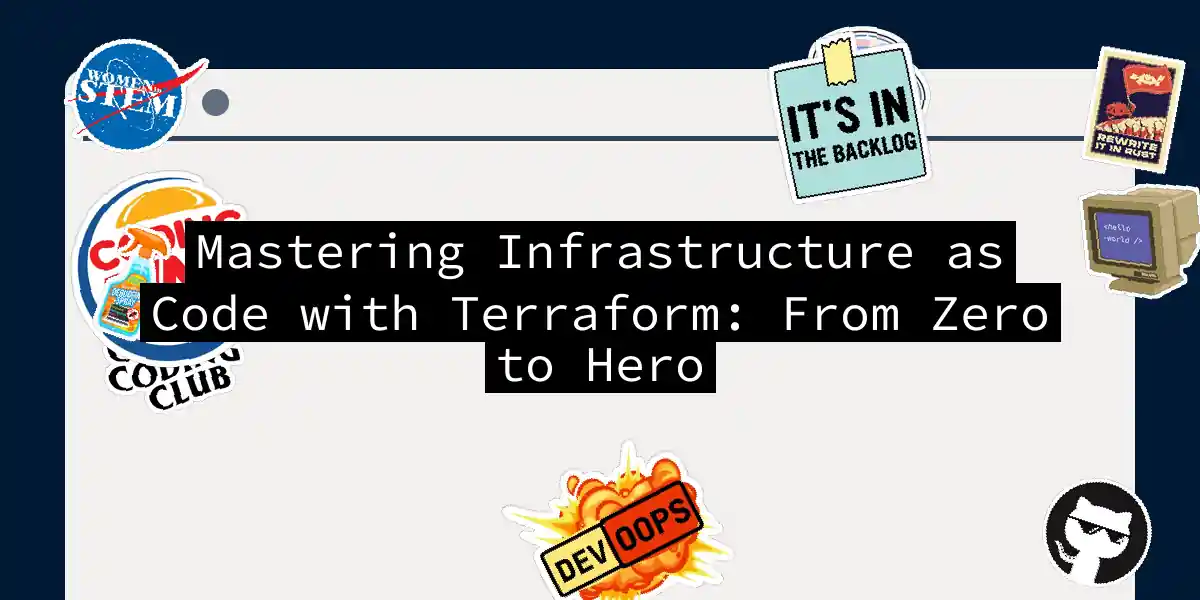Picture this: You’ve just finished crafting the perfect cloud infrastructure - servers humming like well-trained bees, networks tighter than a hipster’s jeans… only to realize you forgot to document how you built it. Enter Terraform, the Swiss Army knife of Infrastructure as Code that lets you version control your cloud like a git repository for real-world resources.
Why Terraform Beats Clicking Buttons (And Your Coworker’s Bad Memory)
Let’s face it - manually provisioning cloud resources through a web console (a.k.a. ClickOps) is like trying to bake a wedding cake using only a toothpick and hope. Terraform brings sanity through:
- Declarative syntax (“I want 5 cupcakes”) instead of imperative micromanagement (“Mix flour, then add sugar…”)
- Version-controlled infrastructure that evolves like your application code
- Multi-cloud flexibility - because putting all your eggs in one cloud basket is so 2023
Your First Infrastructure Recipe
Let’s create an AWS EC2 instance that’s more reliable than your morning coffee routine. Create these files: providers.tf
terraform {
required_providers {
aws = {
source = "hashicorp/aws"
version = "~> 5.0"
}
}
}
provider "aws" {
region = "us-west-2"
}
server.tf
resource "aws_instance" "web_server" {
ami = "ami-1234567890abcdef0" # Ubuntu 24.04 LTS
instance_type = "t2.micro"
tags = {
Name = "MyFirstTerraformedServer"
Role = "WebFrontend"
}
}
Run these commands in order:
terraform init # Installs AWS provider plugins
terraform plan # Shows execution blueprint
terraform apply # Creates actual resources
Congratulations! You’ve just automated what would take 15 clicks in the AWS console. The plan command is your “measure twice, cut once” moment - always check it before applying .
Variables: Because Hardcoding Is for Amateurs
Take your config from “works on my machine” to production-ready with variables: variables.tf
variable "server_port" {
description = "HTTP access port"
type = number
default = 8080
}
variable "environment" {
description = "Deployment stage"
type = string
validation {
condition = contains(["dev", "staging", "prod"], var.environment)
error_message = "Valid environments: dev, staging, prod"
}
}
security.tf
resource "aws_security_group" "web_access" {
name = "web-${var.environment}"
ingress {
from_port = var.server_port
to_port = var.server_port
protocol = "tcp"
cidr_blocks = ["0.0.0.0/0"]
}
}
Now deploy different environments without changing code:
terraform apply -var="environment=prod"
Modules: Your Infrastructure LEGO® Bricks
When your config grows more complex than a Netflix original plot, break it into modules: modules/network/main.tf
resource "aws_vpc" "main" {
cidr_block = "10.0.0.0/16"
tags = {
Name = "web-vpc-${var.env_suffix}"
}
}
resource "aws_subnet" "public" {
count = 2
vpc_id = aws_vpc.main.id
cidr_block = "10.0.${count.index}.0/24"
availability_zone = element(data.aws_availability_zones.available.names, count.index)
}
production.tf
module "prod_network" {
source = "./modules/network"
env_suffix = "prod"
}
This modular approach lets you reuse configurations like Docker containers for infrastructure .
Pro Tips from the Battlefield
- State Management: Store your
terraform.tfstateremotely using S3 + DynamoDB or Terraform Cloud. Local state files belong with floppy disks and dial-up internet - Workspaces: Manage multiple environments like a chef handles kitchen stations:
terraform workspace new staging terraform apply -var-file="staging.tfvars" - Drift Detection: Terraform plan isn’t just for changes - it’s your infrastructure lie detector:
terraform apply -refresh-only
When Things Go Boom: Debugging 101
Hit a snag? Try these:
TF_LOG=DEBUG terraform apply # Verbose logging
terraform validate # Config syntax check
terraform fmt # Auto-format HCL files
Remember that time I forgot a depends_on and created a database before its network existed? Let’s just say cloud bills make excellent motivators for learning proper dependency management.
Destroy Responsibly!
Always clean up test resources unless you enjoy surprise cloud bills:
terraform destroy -target=aws_instance.web_server
For extra safety, add lifecycle rules:
resource "aws_db_instance" "critical_data" {
# ... other config ...
lifecycle {
prevent_destroy = true
}
}
The Future-Proof IaC Workflow
As your infrastructure grows, consider these upgrades:
- Policy as Code: Use Sentinel or OPA to enforce security rules
- CI/CD Integration: Make Terraform part of your deployment pipeline
- Visualization Tools: Generate architecture diagrams automatically from Terraform configs Terraform isn’t just a tool - it’s a paradigm shift. Once you start describing infrastructure as code, you’ll wonder how anyone manages cloud resources without it. Now if you’ll excuse me, I need to go version control my coffee machine settings…
